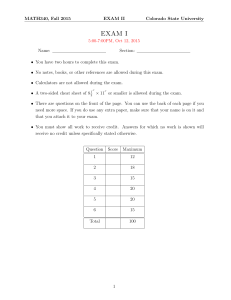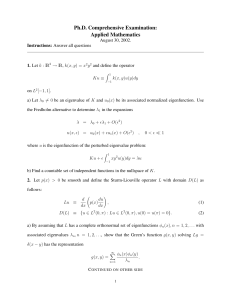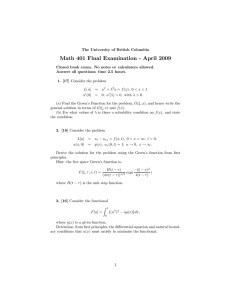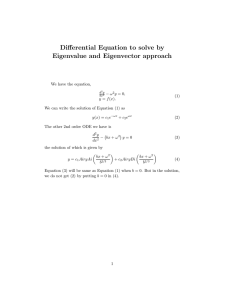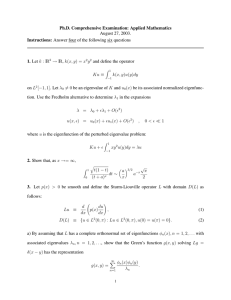Max-min approach to Perron
advertisement
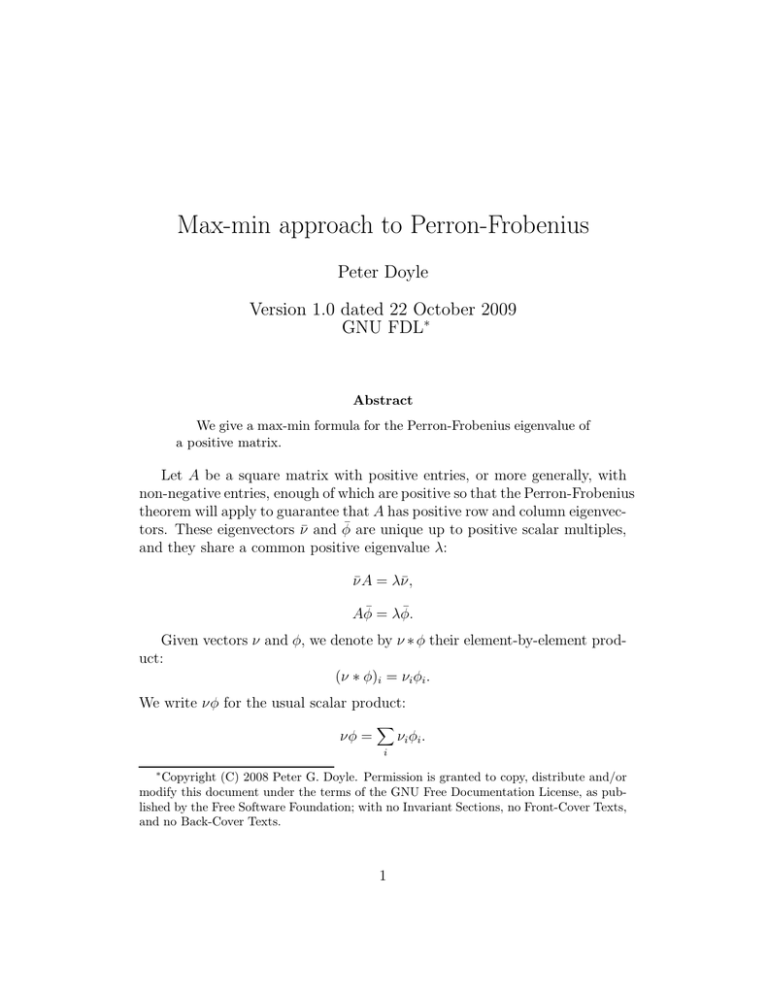
Max-min approach to Perron-Frobenius Peter Doyle Version 1.0 dated 22 October 2009 GNU FDL∗ Abstract We give a max-min formula for the Perron-Frobenius eigenvalue of a positive matrix. Let A be a square matrix with positive entries, or more generally, with non-negative entries, enough of which are positive so that the Perron-Frobenius theorem will apply to guarantee that A has positive row and column eigenvectors. These eigenvectors ν̄ and φ̄ are unique up to positive scalar multiples, and they share a common positive eigenvalue λ: ν̄A = λν̄, Aφ̄ = λφ̄. Given vectors ν and φ, we denote by ν ∗ φ their element-by-element product: (ν ∗ φ)i = νi φi . We write νφ for the usual scalar product: νφ = X νi φi . i Copyright (C) 2008 Peter G. Doyle. Permission is granted to copy, distribute and/or modify this document under the terms of the GNU Free Documentation License, as published by the Free Software Foundation; with no Invariant Sections, no Front-Cover Texts, and no Back-Cover Texts. ∗ 1 This is justified because if we think of ν and φ as row and column vectors, respectively, νφ is just the usual matrix product. Proposition. νAφ λ = max min . µ ν∗φ=µ νφ Here and throughout µ, ν, and φ denote vectors with strictly positive entries. Proof. For any ν we have νAφ̄ = λ, ν φ̄ so taking φ = φ̄ shows that νAφ ≤λ ν∗φ=µ νφ max min µ To prove the inequality in the other direction, take µ = ν̄ ∗ φ̄, and suppose that ν ∗ φ = µ = ν̄ ∗ φ̄. Write νi = ν̄i fi , so that φi = φ̄i /fi . Then νAφ − ν̄Aφ̄ = X ≥ X = X ν̄i Aij φ̄j ( ij fi − 1) fj ν̄i Aij φ̄j log ij fi fj ν̄i Aij φ̄j log fi − X i = λ( ν̄i Aij φ̄j log fj ij ij = X ν̄i λφ̄i log fi − X X λν̄j φ̄j log fj j ν̄i φ̄i log fi − X j i = 0. 2 ν̄j φ̄j log fj ) Thus νAφ ≥ ν̄Aφ̄ = λν̄ φ̄ = λνφ, so νAφ ≥ λ. ν∗φ=µ νφ max min µ Corollary. λ = max min µ P φ i i µi (Aφ) φi P i µi . Note. I found this result and proof back in 1984 by painstakingly discretizing Charles Holland’s variational characterization of the principal eigenvalue of a second-order linear elliptic equation [3, 4]. This theorem applies in particular to diffusion-with-drift processes. To discretize Holland’s result, I created a continuous process on a 1-dimensional simplicial complex with ‘fat nodes’, and took a limit under which diffusion-with-drift on this 1-complex approached a continuous-time but discrete-space Markov chain. Taking the limit of Holland’s proof, so to speak, yielded the proof here. This discretization process took far longer than you would imagine, and it was made more painful by the ever-present suspicion that it should be possible just to write down the discrete analog of Holland’s result. I could likely have done this if I had paid more attention to the closely related work of Donsker and Varadhan [1, 2]. References [1] M. D. Donsker and S. R. S. Varadhan. On a variational formula for the principal eigenvalue for operators with maximum principle. Proc. Nat. Acad. Sci. U.S.A., 72:780–783, 1975. [2] M. D. Donsker and S. R. S. Varadhan. On the principal eigenvalue of second-order elliptic differential operators. Comm. Pure Appl. Math., 29:595–621, 1976. [3] Charles J. Holland. A new energy characterization of the smallest eigenvalue of the Schroedinger equation. Comm. Pure Appl. Math., 30:755– 765, 1977. 3 [4] Charles J. Holland. A minimum principle for the principal eigenvalue for second-order linear elliptic equations with natural boundary conditions. Comm. Pure Appl. Math., 31:509–519, 1978. 4
